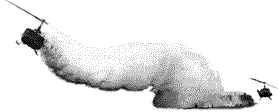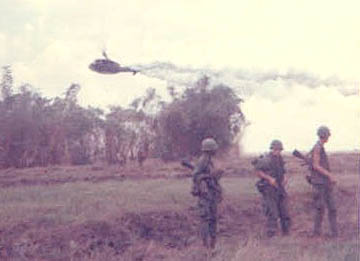Helicopters were not only fun to ride, they were essential to our
support in the field. At remote fire bases, they were our only means of re-supply.
Medevacs carried us to the field hospital at Cu Chi when we were hurt.
Helicopter gunships gave us a chance to pull back when we were pinned down by enemy
fire. And Smokies helped conceal our landing when we were coming in on an airborne
assault.
The first Smokey I saw was while I was on an Eagle flight out of Keane. We were
headed towards a clearing, our flight was descending, and we were going to land up ahead.
Suddenly the trailing chopper in our formation picked up speed and rushed past us,
a cloud of smoke trailing from the engines. My heart skipped a beat. I thought we
must be under fire and the chopper was hit! But the ship continued on, laying down a
thick column of smoke in a large semicircle ahead of us. Of course! The smoke
was to cover our arrival. Our flight set down within the circle. The propwash
soon dispersed the smoke, but by then our Hueys were safely on their way and we were
headed for the nearest cover.
 As the weeks slipped by we saw Smokies regularly. More and more of our time was
spent over by the North Oriental River, with four to five helibornes a day. Whenever
the landing zone was considered dangerous, Smokies came along. Not long after my
first encounter we made an Eagle flight into a terraced clearing. Dense forest ran
down one side and across the front of the landing zone. As our Hueys descended, a
lone chopper dropped out of the tail slot and raced ahead of the column. The pilot
brought his ship to within thirty feet of the ground and poured on the coal. His
engine thundered, and a thick white cloud rolled out behind the chopper. On each
side of the ship a door gunner leaned against his M-60 machine gun, firing into the brush
and trees. The long white cloud stretched out behind the chopper, billowing and
growing until it reached the ground, rolling across the field toward the trees.
As the weeks slipped by we saw Smokies regularly. More and more of our time was
spent over by the North Oriental River, with four to five helibornes a day. Whenever
the landing zone was considered dangerous, Smokies came along. Not long after my
first encounter we made an Eagle flight into a terraced clearing. Dense forest ran
down one side and across the front of the landing zone. As our Hueys descended, a
lone chopper dropped out of the tail slot and raced ahead of the column. The pilot
brought his ship to within thirty feet of the ground and poured on the coal. His
engine thundered, and a thick white cloud rolled out behind the chopper. On each
side of the ship a door gunner leaned against his M-60 machine gun, firing into the brush
and trees. The long white cloud stretched out behind the chopper, billowing and
growing until it reached the ground, rolling across the field toward the trees.
At the far end of the clearing the pilot banked sharply and did an abrupt turn,
wheeling his ship a full 180 degrees to start back. But he turned too fast.
The right-door gunner was thrown right out of the helicopter.
The pilot must have seen him fall, for he instinctively threw the stick to that side.
The Smoky again banked sharply, turning quickly back upon its axis another 180
degrees. Again the results were tragic. Out of the left door flew the other
gunner! Neither of them had been using the required safety belt. That was a
common practice - they could get a better shooting angle without the belts to hold them
back.
The Smoky settled to the ground, and the crew got out to help the gunners. By
then we were on the ground and moving to help. But it was too late for the first
man. He died on impact. The second man was severely injured. In minutes,
a Medevac came to move him to a hospital.
The Smoky pilot was stricken with grief. He wouldn't get back into his chopper.
He didn't ever want to fly again. He just sat on the ground and wept.
Finally, the copilot coaxed him in and took the ship back to Cu Chi. War takes its
casualties in many forms. We didn't all die from hostile fire.
